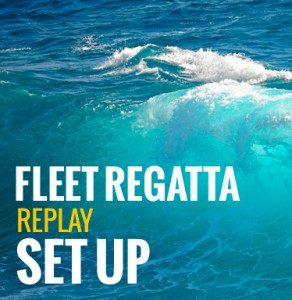In this podcast, we review laylines, ladder rungs, and the danger of getting to close to the edge of the course.
We use raceQs's Match Mode and separation feature to show just how much a lead can change when there is a big wind shift on the course, and talk about the danger of trying to build "leverage" against the fleet.
Welcome to Race to Win, a sailing podcast brought to you by raceQs.com. We review 3D regatta replays and analyze racing tactics, rules, and winning strategies.
My name is Jacon, and this is the first in a series of podcasts about the geometry of the upwind leg. If you’re an experienced racer, please bear with me as I go over some of the basics.
The recording I am using today is from a J/24 regatta in Texas.
First a lot of raceQs users ask us: “How does it know where the wind is coming from?” The wind algorithm for raceQs is fairly complex, but the simple version is that it splits your tacking angles (and everyone else’s) in half. So if all the boats on the race course are tacking from 315 degrees to 45 degrees and back, the wind is holding steady at 0, or true north. If the data shows they are tacking between 305-15 and 35-45, the wind is likely shifting 10 degrees between 350 and 0.
OK, so now that we know where the wind is, let’s talk about laylines a little bit. Most of you probably know what the layline is, and you can see here that raceQs displays two lines coming out of the windward mark. The layline is the hypothetical line on which one needs to tack in order to fetch the mark, or make it to the mark without tacking again.
Important here is the fact that if the wind holds steady, any course (meaning any number of tacks) between the starting line and the windward mark will be exactly the same distance sailed. There are two ways to sail more than the minimum distance:
- Overstanding, or going past the layline, and
– Failing to tack on headers, or head up on lifts
We notice in this recording that the laylines abruptly get wider: there are two possible reasons. In this case, it is because there is different wind on the two sides of the course. The laylines can also become wider if the wind becomes significantly lighter, which would cause the boats to sail at a wider angle relative to the true wind (for higher speed).
Sometimes sailors will ask us…. “How did I fall behind 200 meters in a second? That’s not possible, we weren’t moving that fast.” Of course, they weren’t, but if a major wind shift occurs, they could fall behind exactly that fast. Here, I’ve turned on Match Mode in the raceQs tool: watch what happens between Frankley Scarlet and Bling as the wind shifts left.
As it goes left, Frankly Scarlet develops a huge lead over Bling, very quickly. That’s because until you are outside of the laylines, the boat furthest to windward is winning. Sailors often call this the “ladder rung.” You can see what I mean in raceQs match mode, which shows the ladder rungs around a given boat. The ladder rungs are always perpendicular to the wind: that’s the whole point. The farther up the ladder you are, the better you’re doing. It’s a way to compare the relative progress of two boats on different parts of the course.
Now we watch again as Bling goes far out to the right side of the course, and we see the danger of getting to the outside too early. This is often called building “leverage.” The further out you go early in the leg, the more leverage you have on the fleet: but just as when banks build leverage, it comes with risk. If the shift had gone right instead of left, Bling would have had a big lead. But it went left and they ended up dead last.
The other risk to going outside too early is that a shift will put you outside the layline, which is what happens to Frankly Scarlet. They do much better than Bling, of cours,e, because they are on the left side of the course and the wind went left. But it went so far left that they end up outside the port-tack layline, and thus sail more than the minimum required distance to the mark.











